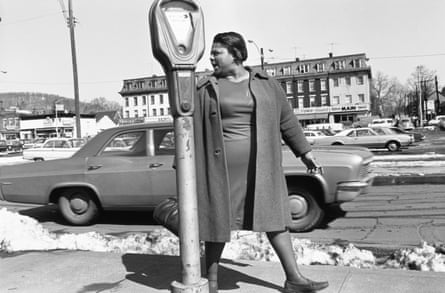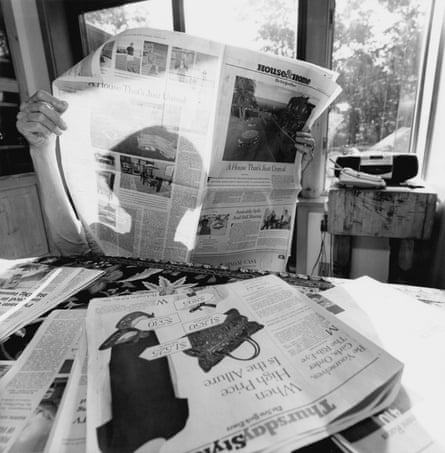[ad_1]
The actor Frances McDormand, who was present when her husband, the film-maker Joel Coen, first met the photographer Lee Friedlander, was struck by their immediate rapport. It was rooted, she writes in her afterword to a new book, Lee Friedlander Framed by Joel Coen, in “a familiarity that comes from their lifetimes of singular and eccentric visions”.
At 88, Friedlander is 20 years older than Coen, and has been looking at the world in his off-kilter way since he first picked up a camera, aged 14. His subject matter is extravagantly wide-ranging, from busy streets and deserted parking lots to the gloomy interiors of motel rooms and shadowy self-portraits, but his style is unmistakeable. “I’m still shooting the same subjects when I go out west,” he said recently. “The more jumble, the better I like them – if they work.”

Against all the odds, though, even the most jumbled or fragmented Lee Friedlander photograph works. His approach has often been described as “cerebral”, an acknowledgment of the fierce compositional rigour that imposes order on what, in lesser hands, would simply be chaotic. Revealingly, Coen was drawn “more to his beautifully strange sense of composition than to any specific subject”, which will no doubt make the resulting book fascinating to Friedlander devotees, but may not be the best place to start for anyone unfamiliar with his vast and challenging archive.
It was Friedlander’s gallerist, Jeffrey Fraenkel, who, having befriended Coen and McDormand during the pandemic – they live in adjacent towns in Marin County – suggested that the director might curate a show of the photographer’s work. “I thought Lee was ripe for an outside approach, and inviting a film-maker seemed like the way to go,” Fraenkel told the New York Times. “Anyone who’s seen Joel’s movies knows he has a special eye for images.” When the pair met, the chemistry was such that both artists felt as if they somehow knew each other.
The book, which accompanies an exhibition at Luhring Augustine in New York that runs until late July, is intriguing as much for what it says about Coen’s offbeat vision as Friedlander’s singular way of seeing. There are 70 images in total, many of which are lesser-known examples of the photographer’s work. They have been selected, as Coen puts it in his short introduction, “to highlight Lee’s unusual approach to framing – his splitting, splintering, repeating, fracturing, and reassembling into new and impossible compositions”.

It begins with a series of landscapes and street scenes bisected by vertical lines: poles, trees, parking meters, steel bars. Your eye is immediately drawn to these bold intrusions, which sometimes partially obscure the people in the photographs or places them at the edges of the composition. It is as good a way as any of announcing that you have entered the world of Lee Friedlander: a strangely familiar place of recurring signs, symbols, jolts and clues that, reflected through Coen’s eyes, suddenly seems cinematic albeit in a distinctly avant garde way.
It’s not just that many of the photographs resemble film stills: frozen moments that suggest a bigger, stranger narrative. Or that they make noirish use of reflected images in car mirrors, glass doors and shop windows. Or that Friedlander, like Hitchcock, appears, as a reflection or a shadow, in many of his own creations. More specifically, it’s the sense that the everyday landscapes in which the Coen brothers set films such as Fargo, The Big Lebowski or Barton Fink are not that far removed from the American terrain that Friedlander has made his own over six decades.

His photographs often evoke the energy of urban life in anonymous cities: the sense of individuals constantly on the move through crowded or deserted streets and revolving doors, and the suggestion that something is happening just out of frame, or is about to happen in the next shot. Sometimes, though, nothing is happening at all on Friedlander’s empty lots and half-empty car parks, and that eerie emptiness is also redolent of certain establishing shots from Coen brothers’ films, which always tend to take their own sweet time to get where they are going. In both cases, the unexpected and the almost mundane exist in an uneasy harmony that makes you wonder, as McDormand puts it: “Why, how and what did they see?”

For McDormand, Friedlander’s images and Coen’s films “hold mysteries that feel a bit connected”. Likewise, their respective ways of seeing seem somehow interlinked. “They both,” she concludes, “capture and fill frames with sometimes simple and other times chaotically elaborate images that cause us to wonder. Not to browse and swipe, but to wonder. And perhaps to allow some things into our heads we’ve never thought about before and think… Huh.”
[ad_2]